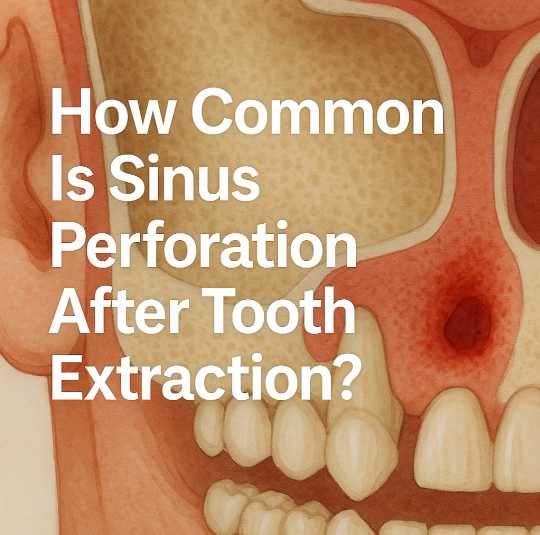Sinus perforation, also known as an oroantral communication (OAC), is a possible complication after extracting upper back teeth, especially upper molars and premolars, which are located close to the maxillary sinus.
Here’s how common it is, what causes it, and what you should know.
🦷 How Common Is It?
- Sinus perforation is relatively uncommon, but not rare.
- Studies estimate it occurs in approximately 0.5% to 5% of upper tooth extractions, depending on the tooth location, patient anatomy, and extraction technique.
Risk by Tooth Type:
| Tooth | Risk Level |
|---|---|
| Upper first molars | Higher risk |
| Upper second molars | Moderate risk |
| Upper premolars | Lower risk |
| Lower teeth | Very low to none |
✅ The risk increases when the roots are close to or within the sinus cavity.
🧠 Why Does It Happen?
- The roots of upper teeth can be separated from the sinus by a very thin bone layer—or none at all in some people
- During extraction, this barrier can be accidentally torn or removed, creating a small hole between the mouth and the sinus
⚠️ Signs of a Sinus Perforation
- Feeling of air passing between mouth and nose
- Liquid entering the nose when drinking
- Whistling sound while breathing
- Persistent sinus pain or pressure
- Visible hole in the extraction site
🛠 Is It Serious?
- Small perforations (<2mm) often heal on their own within a few weeks
- Larger openings may require:
- Stitches or flap surgery
- Bone grafts or membrane to close the defect
- Antibiotics to prevent sinus infection (sinusitis)
🩺 How to Prevent It
- Dentists or oral surgeons:
- Assess X-rays or CBCT scans before extraction
- Use gentle techniques
- May plan for surgical extraction to reduce force
If you’re at high risk, your dentist may warn you in advance and prepare accordingly.
Conclusion
Sinus perforation after tooth extraction is not very common but can occur, especially with upper molars. It affects roughly 1–5% of cases, depending on the individual’s anatomy. Most small perforations heal naturally, but larger ones may need surgical repair.
If you experience symptoms after an extraction, contact your dentist or oral surgeon immediately for proper evaluation and treatment.
Also Check:
• How Bad Does A Root Canal Hurt 1-10
• How Can You Tell If a Verruca Is Dying?
• How Can I Hide Varicose Veins?
• How Accurate Is WHOOP Calories?
Share this content:


